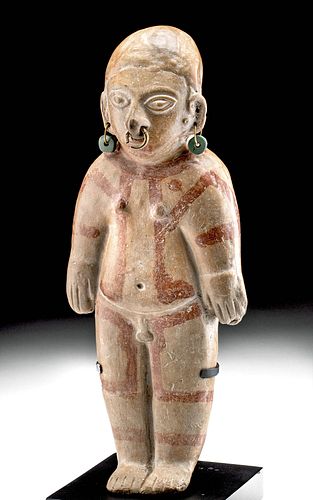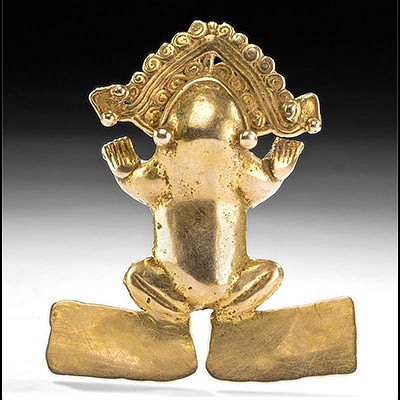La Tolita-Tumaco Pottery Hermaphrodite Ocarina w/ Gold
Lot 90
About Seller
Artemis Gallery
686 S Taylor Ave, Ste 106
Louisville, CO 80027
United States
Selling antiquities, ancient and ethnographic art online since 1993, Artemis Gallery specializes in Classical Antiquities (Egyptian, Greek, Roman, Near Eastern), Asian, Pre-Columbian, African / Tribal / Oceanographic art. Our extensive inventory includes pottery, stone, metal, wood, glass and textil...Read more
Estimate:
$2,750 - $4,000
Absentee vs Live bid
Two ways to bid:
- Leave a max absentee bid and the platform will bid on your behalf up to your maximum bid during the live auction.
- Bid live during the auction and your bids will be submitted real-time to the auctioneer.
Bid Increments
| Price | Bid Increment |
|---|---|
| $0 | $25 |
| $300 | $50 |
| $1,000 | $100 |
| $2,000 | $250 |
| $5,000 | $500 |
| $10,000 | $1,000 |
| $20,000 | $2,500 |
| $50,000 | $5,000 |
| $100,000 | $10,000 |
| $200,000 | $20,000 |
About Auction
By Artemis Gallery
Aug 13, 2020
Set Reminder
2020-08-13 10:00:00
2020-08-13 10:00:00
America/New_York
Bidsquare
Bidsquare : Fine Antiquities, Ethnographic & Fine Art
https://www.bidsquare.com/auctions/artemis-gallery/fine-antiquities-ethnographic-fine-art-5415
Features classical antiquities, ancient and ethnographic art from cultures encompassing the globe. Egyptian, Greek, Roman, Etruscan, Near Eastern, Asian, Pre-Columbian, Native American, African / Tribal, Oceanic, Spanish Colonial, Russian, Fine Art, so much more! Artemis Gallery info@artemisgallery.com
Features classical antiquities, ancient and ethnographic art from cultures encompassing the globe. Egyptian, Greek, Roman, Etruscan, Near Eastern, Asian, Pre-Columbian, Native American, African / Tribal, Oceanic, Spanish Colonial, Russian, Fine Art, so much more! Artemis Gallery info@artemisgallery.com
- Lot Description
Pre-Columbian, Ecuador or Colombia, La Tolita-Tumaco culture, ca. 1st century BCE to 4th century CE. A hollow-built pottery hermaphrodite ocarina figure of a tall and intriguing form presenting nude atop fused legs and broad feet. The androgynous individual has a petite phallus and scrotum beneath a grooved waistline as well as perky breasts atop the chest, and broad strokes of red-orange slip pigment create vibrant linear motifs atop the highly burnished, tan-hued ground. The proportionate head stares forward with almond-shaped eyes and displays a 50% gold (equivalent to 12K) wire ring through the septum. Two additional 25% gold earrings are suspended from the ear lobes and bear thick, cylindrical beads carved from mottled greenstone. Two tone holes along the verso produce two different notes when air is blown through the opening atop the head. A finely preserved figural example with expert stylization. Size: 5.625" W x 13.4" H (14.3 cm x 34 cm); 14.375" H (36.5 cm) on included custom stand; quality of gold: nose ring is 50% (equivalent to 12K) and earrings are 25%.
For an example of a seated figure displaying similar gold ornamentation, please see The Metropolitan Museum of Art, accession number 1991.436.7a,b
Provenance: private Hawaii, USA collection; ex-private Kalina Musical collection, California, USA; ex-private T. Misenhimer collection, Beverly Hills, California, USA, collected from 1970 to 2008
All items legal to buy/sell under U.S. Statute covering cultural patrimony Code 2600, CHAPTER 14, and are guaranteed to be as described or your money back.
A Certificate of Authenticity will accompany all winning bids.
We ship worldwide and handle all shipping in-house for your convenience.
#108985Professional repairs to head, right shoulder, legs, and feet, with restoration along areas of shoulder and feet, and resurfacing with overpainting along new material and break lines. Gold nose ring repaired from two large pieces, with small chips along midsection. Abrasions and fading to original pigment, with light encrustations within some recessed areas. Nice remains of original pigment throughout. Ocarina produces two different tones when played.Condition
- Shipping Info
-
All shipping is handled in-house for your convenience. Your invoice from Artemis Gallery will include shipping calculation instructions. If in doubt, please inquire BEFORE bidding for estimated shipping costs for individual items.
-
- Buyer's Premium



 EUR
EUR CAD
CAD AUD
AUD GBP
GBP MXN
MXN HKD
HKD CNY
CNY MYR
MYR SEK
SEK SGD
SGD CHF
CHF THB
THB














